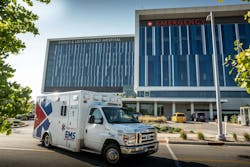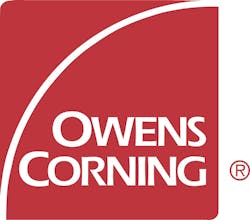Thermafiber® RainBarrier® Manages Moisture in a Historic Hospital Enclosure
By Owens Corning
An Example of Harvesting and Repelling Water
Although the Sidney & Lois Eskenazi Hospital is one of Indiana’s newest hospitals, the health care campus is deeply rooted in Indianapolis’s history. Founded as Indianapolis City Hospital in 1859, in response to a smallpox epidemic, the hospital was used during the Civil War to care for Union soldiers. The hospital’s name changed several times over the decades before it re-opened in December 2013, with a new name and entirely new facilities located just 1,300 feet West of the original campus.
Eskenazi’s legacy of care is expanded today with programs that advance sustainability and wellness throughout the community. Certified in 2015 as Indiana’s first LEED Gold building – and one of the largest LEED Gold healthcare campuses in the world – the hospital features a 35,000-square-foot green roof and sky farm, and an air filtration system that draws in outside air, which is treated, conditioned, filtered, and used only once before exiting the hospital.
Water features play a vital role in the design of the hospital which features healing gardens and a rainwater harvesting system that supplies 100 percent of the campus’s irrigation needs. However, moisture management isn’t confined to the hospital’s rainwater harvesting system or stormwater treatment and infiltration systems that support the neighboring White River ecosystem. Managing moisture also extends into the design of the hospital enclosure; specifically the exterior wall assembly. Managing liquid water and moisture vapor throughout the enclosure is a necessity during the Midwest’s humid summers, and drenching rains. Used as a continuous insulation, Owens Corning® Thermafiber® RainBarrier® efficiently repels and drains water from the wall cavity system, while also delivering energy efficiency and fire-resistant properties.
In addition to mitigating liquid and vapor moisture in exterior walls, mineral wool insulation delivers other qualities to the health care environment that support sustainability, thermal performance and even noise control. Photo credit: Eskenazi Health
David Williams, senior project manager, Quality Interiors, Inc., witnessed firsthand how mineral wool stood up to drenching rains during construction. “We had our own version of a Midwest monsoon come through and I received a call from the hospital’s transition team saying they were worried a lot of job site material was getting wet on the insulating material,” Williams recalls. He calmed the caller’s concerns, noting that the product – RainBarrier® – was literally living up to its name. “I said, ‘Are you kidding? It’s designed to repel water,” Williams recalls, adding that the insulation had completely dried by the time members of the transition team came over to check out the concern.
Among mineral wool’s diverse performance properties, its ability to manage both liquid and vapor is especially important in the wall cavity system where it is imperative that water not become trapped inside the cavity. With a minimal sorption of just 0.03%, even in the harsh climatic conditions measured by ASTM C114 (120◦F, 95% humidity for 96 hours), Thermafiber® insulation delivers consistent thermal performance throughout the thickness of the mineral wool. And when mineral wool does get wet, its specially engineered properties help it quickly revert to a dry state. The ability to repel moisture and revert to a dry state following exposure, makes mineral wool a solid choice for continuous insulation in the exterior assembly.
Owens Corning 1-800-GET-PINK[email protected]www.owenscorning.com

